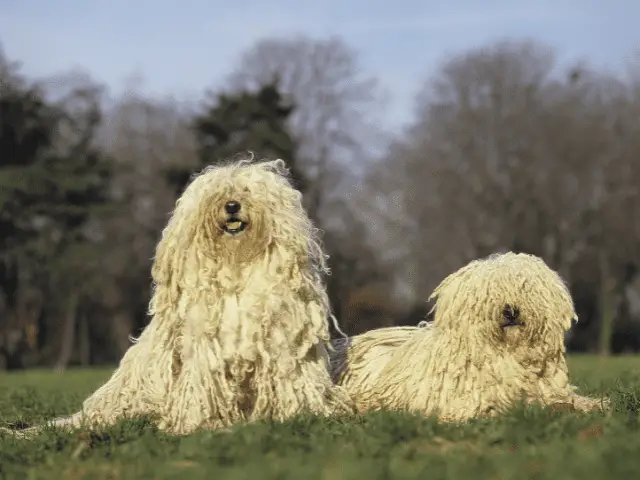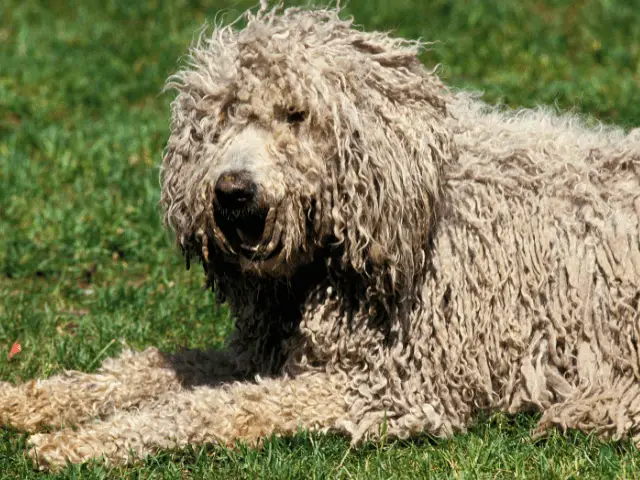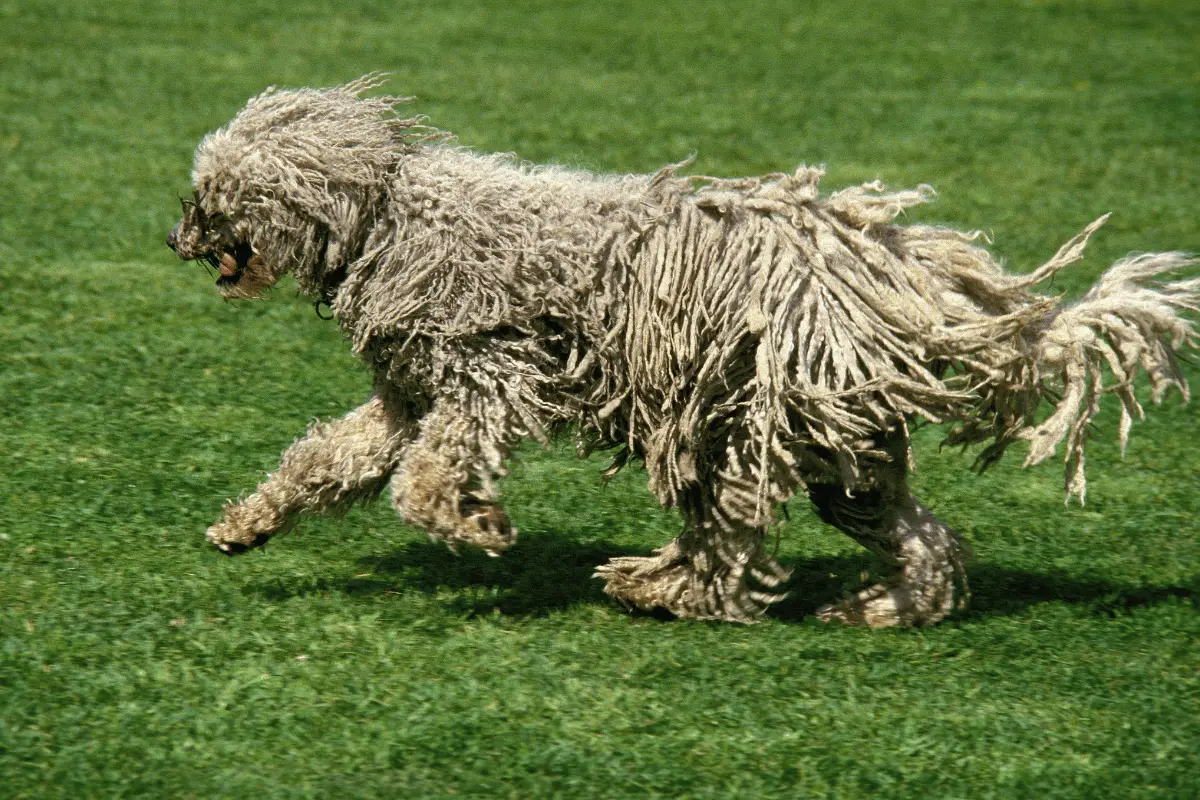You might not hear the Komondor mentioned as frequently as other popular dog breeds, but almost everyone is familiar with the image of the large, white dog with corded hair that protects sheep and cattle, often affectionately referred to as “mop dogs”.
This distinctive breed is the Komondor, or the Hungarian sheepdog, a powerful and long-established Hungarian dog breed dating back to at least the 1500s.
They are on the larger side, with females weighing up to 100 pounds and males weighing up to 130 pounds, and their long, muscular legs, although hidden beneath their corded coat, make them strong and capable guardians of the livestock they are tasked with protecting.
The Komondor is considered a national treasure of Hungary, officially declared by the Hungarian parliament as a breed to be protected and preserved due to their cultural and economic importance to the country, as well as their role in Hungary’s national identity. The maintenance of the species, without alteration, is promoted as a vital state task, ever since an official declaration in 2004.
Although Komondors are still used on farms and ranches to protect livestock from predators, their unique look and gentle temperament have also made them desirable to active, adventurous individuals or families looking for a companion dog.
However, because they are so unique and require such specific care, it’s easy for dog owners to feel uncertain about their Komondor’s needs.
While the breed is best suited to owners with a decent amount of experience caring for dogs, understanding the activity, grooming, and health requirements that a Komondor has will make it easier for anyone to integrate these loving pups into their normal daily activities – like hiking!
Can Komondors Go On Hikes?

As livestock guarding dogs, Komondors are built to spend long hours outdoors and tolerate a decent amount of physical activity. In terms of strength and stamina, they are perfectly capable of accompanying you on a hike, despite the reservations that some might have about hiking such an uncommon breed.
That said, there are some parts of a Komondor’s lifestyle or temperament that may make hiking with them different from hiking with other types of dogs. Making yourself aware of these possibilities now will allow your first hike with your Komondor to be a more smooth, more relaxed experience.
Komondors are very protective and territorial, and if they have no livestock to guard, then they will simply guard their human family instead.
This can be useful at home, where you know that no intruder will be able to make it past your fierce companion, but it has the potential to cause issues when hiking on a public trail. Your Komondor will protect those it is hiking with from anything it perceives as a predator, whether that perception is accurate or not.
Other dogs, wild animals, and unfamiliar humans may send a Komondor into defense mode unless it is made clear that they present no real danger.
A Komondor may also approach or attempt to chase away wildlife that it may see as a predator, such as bears, in situations where you would rather get away quietly. Farm Komondors need to be able to make independent decisions, as they are typically the sole guardian of their charges, so it can be hard to discourage them from doing this in the moment.
When working on a farm or ranch, the Komondor’s peak working hours are at night, so it tends to rest during the day. This may not be an issue if your pup has successfully acclimated to your household routine, but don’t be surprised if they are resistant to excessive activity during the hours that make the most sense to you.
How to Prepare for Hiking with A Komondor
Fortunately, these potential issues can largely be avoided if you prepare for hiking with your Komondor in advance.
For instance, their behavior towards strange humans and dogs can be corrected if your pup is properly socialized.
By regularly introducing them to new human and canine friends from a young age, you can show them through their experiences that most strangers are not dangerous or threatening. You may even develop a system for indicating to your dog that the new person or animal is not a threat so that they know they don’t need to guard you against them.
Proper training can also be used to teach your Komondor to ignore wild animals and to listen closely for commands from you. This type of obedience may be harder to teach since they are bred to be independent thinkers rather than to follow orders, but having patience and establishing trust with your dog will still get you there in the end.
Not much can be done to change the natural circadian rhythm of Komondors, but you can find compromises with it; you can hike your dog closer to early morning or late evening than the middle of the day so that it feels more natural for them to be awake and active.
Or, you can bring them on your hike at any time you please, as long as you remember that they may not be quite as energetic as you and could need some extra naptime afterward.
When hiking your Komondor for the first time, remember to start with shorter distances and build up over time, so that you can learn their tolerance for hiking and they can gradually increase their endurance for it.
Grooming Considerations

As anyone knows who has seen a Komondor before, they have long, dense coats of hair that develop into cords as they grow into adulthood. Proper maintenance of this coat is an important part of being a Komondor owner, and it should factor into your hiking decisions.
The cords should be separated at least every week to keep them neat, and increased activities like hiking may mean more frequent cord maintenance. They should never be brushed, so debris that may accumulate on a hike has to be removed manually.
It’s also important to check for ticks or fleas after a hike, and this process is likely to take longer than it does for other breeds. Although their cords help to protect them from the bite of larger predators, like wolves, small parasites are still able to get down to their skin, so owners have to be vigilant.
In the event that they do pick up parasites on the trail, it will likely be more difficult and time-consuming to treat than it would be with another breed, but that’s all the more reason to catch these things early before an infestation gets bad.
Komondors also need to be bathed pretty frequently, and their bathing schedule could play a pretty big role in when you are able to hike them. Bathing a Komondor can take a while, and afterward, they usually require several days to dry.
Hiking with a Komondor when they are drying off after a bath has the potential to create mud, pick up extra debris, or simply make them uncomfortable, depending on the weather. You may also find that hiking them increases the frequency of their baths if the trail you choose has opportunities for dogs to get especially muddy or dirty.
Health Considerations
Hip dysplasia is one of the biggest health risks faced by the Komondor breed. Although this is likely a genetic condition that cannot be totally prevented, appropriate activity levels and monitoring of joint health can reduce the risk or make the condition less serious in your pup.
Firstly, you should always avoid hiking or running with them before they have reached adult size. Big dogs like Komondors do mature a bit more slowly, but they typically reach their full size around 18 months.
For a female Komondor, this will be at least 80 pounds, and for a male, at least 100 pounds. Their coat will also be a good indicator of this; Komondor puppies do not have corded coats, but cords slowly develop as they reach adulthood.
If your dog does develop hip dysplasia or other joint problems, be sure to consult your veterinarian about how to change their activity level or monitor their progress to keep their joints as healthy as possible.
The other serious health concern for Komondors is bloat, a condition that all large dog owners have to look out for. This condition is life-threatening if not treated quickly, but luckily, there are many steps you can take to prevent it.
Komondors need to eat and drink quite a bit to support their large size and active lifestyle, but raising their food and water bowls to an elevated platform and using a slow feeder bowl can prevent bloat at mealtime. Give them at least 30 minutes to an hour in between feeding and hiking, or any other activity, to further reduce the risk of bloat.
Large dogs like Komondors also get dehydrated easily during long activities like hikes, so offer plenty of fresh water and consider investing in a portable water bowl to keep them cool and healthy on your hikes.
More Links and Info
Have more dogs in your pack? Zenful Hiking has dozens of breed-specific hiking guides including other breeds like Chihuahuas and Australian Cattle Dogs.

